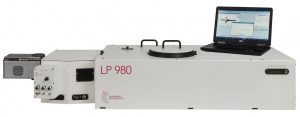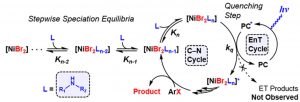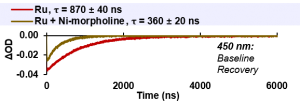Elucidating Photocatalysis Mechanisms using Transient Absorption; Energy and Electron Transfer in Ni-Amine Complexes for C-N Cross-Coupling Reactions
Research Highlight
Light-driven photocatalytic reactions are featured prominently across all fields of science, from the energetically uphill processes of photosynthesis in plants, to water-splitting solar fuels, and even disinfection of water, and improving synthetic reactions. Central to understanding these reactions are the nature of the intermediate species created, and processes by which energy or electrons are transferred to form the desired products. The Edinburgh Instruments LP980 Transient Absorption (Flash Photolysis) Spectrometer is the world’s only commercially available system to feature dual detector options for direct kinetic and spectral measurements required to observe and distinguish the photocatalytic reaction mechanisms, and allow researchers to understand and optimize their reaction conditions for high-yield results.
Figure 1: The Edinburgh Instruments LP980 Spectrometer.
Research
At Colorado State University, under the direction of Prof. Garret Miyake, researchers have cleverly utilized an Edinburgh Instruments LP980 Transient Absorption Spectrometer to show, for the first time, the mechanistic energy transfer (EnT) pathways in a recently discovered dual-catalytic, light-driven C-N photocatalytic cross coupling reaction based on Ni-amine complexes that is very advantageous over its Pd-based alternatives in terms of materials, cost, and sustainability.
Figure 2: Exemplar Ni-amine dual catalytic cross-coupling reactions explored in this article.
By utilizing [Ru(bpy)3]Cl2, a photocatalyst (PC) with well-known excited state and radical transient species, the researchers were able to directly support an energy transfer (EnT) mechanism instead of an electron transfer mechanism in the cross-coupling reaction. Further, this knowledge enabled selection of a phenoxazine PC that performed better than [Ru(bpy)3]Cl2 in 12 of the 13 C–N coupling reactions explored. Figure 3 shows the focus of this work using transient absorption; the quenching step in the reaction diagram follows a direct Stern-Volmer process by observing changes in the lifetime of the PCs.
Figure 3: (Top) The dual catalytic cycle and the PC quenching step probed by transient absorption and (bottom) an example of the lifetime changes during quenching as measured by the LP980 Transient Absorption Spectrometer.
Conclusion
Transient absorption is a powerful tool to study the excited states and radical species during energy and electron transfer; by probing the transient species involved during photocatalysis, researchers can identify and optimize the pathways associated with light-driven reactions.
Read the full Article:
https://pubs.acs.org/doi/10.1021/jacs.9b11049
Figures reprinted with permission from J. Am. Chem. Soc. 2019, 141, 19479.
Download this Application Note:
Download a pdf of our Application Note: Elucidating Photocatalysis Mechanisms using Transient Absorption; Energy and Electron Transfer in Ni-Amine Complexes for C-N Cross-Coupling Reactions
LP980 Transient Absorption Spectrometer
This research was carried out using Edinburgh Instrument’s cutting-edge LP980 Transinet Absorption Spectrometer.
If you have found this Application Note interesting and would like to hear more from us regarding our latest research and products, please take a moment to follow us on social media and sign up to our infrequent enewsletter. Alternatively, if you would like to speak to a member of our team, please get in touch, we look forward to hearing from you.












